Sole Sourcing Modern Management Theory:
Quality as the Source
Sixth National Quality Management Conference
January 28, 1994
Richard E. Winder, J.D., M.B.A.
Copyright 1994, Richard E. Winder. All Rights Reserved.
ABSTRACT
The Five Dimension Quality Model provides a framework for understanding the dynamics
and dimensions of quality. The Model elucidates not only how quality works, but why it
works. Moreover, since the Five Dimension Model incorporates the dynamics and paradigms as
well as the surface structure of quality, it integrates several modern management
techniques, including reengineering, organizational learning, and system dynamics. With
this integration, quality becomes a source (rather than a competitor) of modern management
theory, permitting a concentrated strategic planning focus on quality rather than a
fractured focus on a potpourri of otherwise unrelated management methods.
INTRODUCTION
They are fleeing the quality movement. This would not be a matter of such concern if it
were not for the fact that they are providing some of the deepest insight into quality
processes. Who are they? They are some of the modern management gurus. Michael Hammer and
James Champy, for example, insist that "reengineering [is not] the same as quality
improvement, total quality management, or any other manifestation of the current quality
movement."(1) Business Week implies that
quality philosophy is being replaced by modern management theories as quality gurus age.(2) Newsweek emasculates quality, pointing to several
business failures of quality-focused firms.(3) Is total
quality management dying? Karl Albrecht says it is.(4)
In a world in which major management fads are greeted with suspicion and enjoy a life
cycle of less than a decade, quality was seen as a refreshing bright spot on the horizon.
It appeared to have some permanence. Joel Barker, for example, says that the quality
paradigm is essential to excel in the 90's, but by the next decade it will be a
requirement for even being in business.(5) Dr. Thomas Lee
said that the quality movement is a groundswell movement, like none we have seen this
century, which will (because of its grass roots development) pervade our socioeconomic
environment.(6)
The problem is that quality itself is fragmented. The world has not discovered a
universal theory of quality, so everyone looks at one or more pieces of quality, and the
pieces do not look the same. As noted by Jeffrey Lowenthal, ". . . you will find
about fifty seven different variations to the theme of quality, about 1,265 books on the
subject, and approximately 5,567 articles."(7)
Moreover, as a result of (or perhaps leading to) this fragmentation, there is no clear
vision of what quality is. Less than 7% of over 700 participants (including a number of
quality professionals) in several quality workshops and seminars responded positively to
the question, "How many of you have a definition of quality with which you feel
comfortable."
Dr. Deming says that every system must have an aim.(8)
Quality itself is a system which is either mapped over, adjunct to or integrated with an
organization's operational system. If we do not understand what quality is, then the
quality system remains an aimless system. Fragmentation occurs when aimless systems
wander. That is why there are fifty seven different variations on the quality theme. That
is why we see some modern management gurus avoiding the bad press of quality. Why would
they want to be associated with aimless wandering?
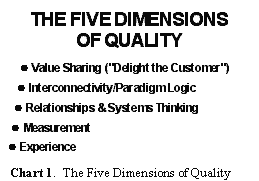 If modern
management theory is to be integrated with quality, we must first have a quality framework
that itself is complete. A recent shift in paradigms has opened the door to a five
dimensional quality framework that is comprehensive, integrative, and simple (see Chart 1
and The Five Dimensions of Quality chart at the end of this paper).(9)
This framework reflects underlying dynamics in a manner that it accounts for
competitiveness as well as competition, for partnership as well as punishment, for
leadership as well as management or bureaucracy.(10)
Utilizing this framework, the Five Dimension Quality Model provides an entirely new
definition of quality which is broad enough to encompass the fifty seven varieties of
quality as well as the emerging management theories.
If modern
management theory is to be integrated with quality, we must first have a quality framework
that itself is complete. A recent shift in paradigms has opened the door to a five
dimensional quality framework that is comprehensive, integrative, and simple (see Chart 1
and The Five Dimensions of Quality chart at the end of this paper).(9)
This framework reflects underlying dynamics in a manner that it accounts for
competitiveness as well as competition, for partnership as well as punishment, for
leadership as well as management or bureaucracy.(10)
Utilizing this framework, the Five Dimension Quality Model provides an entirely new
definition of quality which is broad enough to encompass the fifty seven varieties of
quality as well as the emerging management theories.
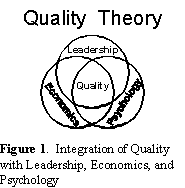 Integrating psychology,
leadership, and economics with quality dynamics, the Five Dimension Model utilizes
relational economic theory to lay a socioeconomic foundation for seeing quality as the
source of modern management theory rather than as a separate method or system (see Figure
1). The distinct advantage of this approach is that it provides a single source of
learning and permits an organization to focus its entire energy on building its strategic
plan around the quality paradigm rather than on an unfocused potpourri of methods. In a
symbionic manner, these modern management methods in turn make a significant contribution
to our understanding of quality. In fact, reengineering (Michael Hammer), organizational
architecture (David Nadler), principle-centered leadership (Stephen R. Covey),
organizational learning (Peter Senge), core competencies (C. K. Prahalad), and time-based
competition (George Stalk, Jr.), are multi-dimensional quality functions that lead us to
the highest (fifth) dimension of quality: delight the customer. These tools take us beyond
the shallow two-dimensional linear view of quality and even beyond the three dimensional
process view to a complete five-dimensional view of the quality system and its underlying
dynamics.
Integrating psychology,
leadership, and economics with quality dynamics, the Five Dimension Model utilizes
relational economic theory to lay a socioeconomic foundation for seeing quality as the
source of modern management theory rather than as a separate method or system (see Figure
1). The distinct advantage of this approach is that it provides a single source of
learning and permits an organization to focus its entire energy on building its strategic
plan around the quality paradigm rather than on an unfocused potpourri of methods. In a
symbionic manner, these modern management methods in turn make a significant contribution
to our understanding of quality. In fact, reengineering (Michael Hammer), organizational
architecture (David Nadler), principle-centered leadership (Stephen R. Covey),
organizational learning (Peter Senge), core competencies (C. K. Prahalad), and time-based
competition (George Stalk, Jr.), are multi-dimensional quality functions that lead us to
the highest (fifth) dimension of quality: delight the customer. These tools take us beyond
the shallow two-dimensional linear view of quality and even beyond the three dimensional
process view to a complete five-dimensional view of the quality system and its underlying
dynamics.
TEXT
Like sole supplier sourcing, sole sourcing modern management theory, with quality as
the source, provides many advantages to the organization:(11)
It permits the organization to build an "arms around" (rather than an "arms
length") relationship with quality. It permits innovation and development around a
single focus rather than around a fractured focus which fragments the system through a
constant pursuit of the latest fads. It saves the time and expense of "shopping
around"--constantly evaluating competing products or services--and permits focusing
of energy and resources on supporting and enhancing quality as the single source. It
"reduces variation in product" through a consistent, unified approach; and it
eliminates time wasted in "changeover" which occurs when the organization moves
from fad to fad. It "simplifies accounting and paperwork" by eliminating the
policy, paperwork, and accountability systems that are inevitably constructed around each
new management method. Yet quality, as a trusted source of supply, is reliable. It
"holds up its responsibility for continual improvement" and remains on the
cutting edge of innovation because its five dimension framework is able to absorb,
integrate, and even elucidate consistent management practices and at the same time
evaluate and reject management fads that would be detrimental to the organization.
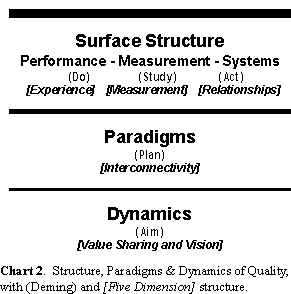 The Five Dimension
Quality Model, based on the five dimensions of quality, provides the means of integrating
cutting-edge management methods with quality processes. The reason the Five Dimension
Model is able to integrate modern management methods is that it deals with quality on the
surface level as well as on the paradigm and underlying dynamic level (see Chart 2). The
vast majority of quality training today takes place at the surface level. It is behavioral
oriented, and deals with what we can see and "control." On the other hand, both
quality and the most significant modern management methods have their roots at the dynamic
level, and must be understood and explained through dynamics rather than through surface
appearances and structures. On the surface, modern management techniques may appear quite
different from traditional quality processes. But at their core, they utilize the same
dynamic interactions. The Five Dimension Model assists us in linking quality with modern
management at the dynamic level, where the focus is on creating the environment in which
growth is natural because it results from nurturing the dynamics rather than controlling
the behavior. This gives us the ability to see modern management methods as part of,
rather than distinct from, quality systems and processes.
The Five Dimension
Quality Model, based on the five dimensions of quality, provides the means of integrating
cutting-edge management methods with quality processes. The reason the Five Dimension
Model is able to integrate modern management methods is that it deals with quality on the
surface level as well as on the paradigm and underlying dynamic level (see Chart 2). The
vast majority of quality training today takes place at the surface level. It is behavioral
oriented, and deals with what we can see and "control." On the other hand, both
quality and the most significant modern management methods have their roots at the dynamic
level, and must be understood and explained through dynamics rather than through surface
appearances and structures. On the surface, modern management techniques may appear quite
different from traditional quality processes. But at their core, they utilize the same
dynamic interactions. The Five Dimension Model assists us in linking quality with modern
management at the dynamic level, where the focus is on creating the environment in which
growth is natural because it results from nurturing the dynamics rather than controlling
the behavior. This gives us the ability to see modern management methods as part of,
rather than distinct from, quality systems and processes.
THE TRADITIONAL QUALITY MODEL
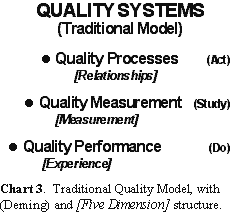 The Five Dimension
Quality Model provides a basis for understanding that quality is a system and for
understanding what the quality system is. The traditional view of the quality system
identified three components: Quality Performance, Quality Measurement, and Quality Systems
and Processes (see Chart 3). These components comprise the first three dimensions of
quality: Experience, Measurement, and Relationships and Systems Thinking.(12)
They also comprise the Do-Study-Act phases of Dr. Deming's Plan-Do-Study-Act (PDSA) cycle
for continuous improvement (also known as the Plan-Do-Check-Act, or PDCA cycle).
The Five Dimension
Quality Model provides a basis for understanding that quality is a system and for
understanding what the quality system is. The traditional view of the quality system
identified three components: Quality Performance, Quality Measurement, and Quality Systems
and Processes (see Chart 3). These components comprise the first three dimensions of
quality: Experience, Measurement, and Relationships and Systems Thinking.(12)
They also comprise the Do-Study-Act phases of Dr. Deming's Plan-Do-Study-Act (PDSA) cycle
for continuous improvement (also known as the Plan-Do-Check-Act, or PDCA cycle).
The First Three Dimensions of Quality. At the experience level,
quality performance is actually achieved--whether by accident, by serendipity, or by plan.(13) Measurement provides us with knowledge of the system and
verifies or refutes that what is expected to happen is happening.(14)
As we see and judge relationships from the data obtained through measurement we are able
to structure systems and processes to ensure consistency and to focus on
"building-in" quality rather than "inspecting it in."(15)
While the traditional quality system has been extremely useful for a number of years
and has brought us to the quality decade, it is now proving inadequate to respond to new
demands of quality, as quality moves from the "customer satisfaction" standard
to "delight the customer" and from structured management systems to employee
empowerment. It was easy to understand the science of quality in terms of the "hard
side" of quality which can be measured and processed on a scientific basis. But now
the practice of quality has moved to its "soft side," where planning and human
issues of customer delight and employee empowerment are becoming more and more critical.
Our traditional quality system does not give us the tools to handle this "soft
side" of quality. The "soft side" requires a whole new set of tools, which
are now emerging as modern management methods. In fact, one writer (erroneously) concludes
that the movement toward the soft side means that we can now ignore the tools of the hard
side.(16)
THE FIVE DIMENSION QUALITY MODEL
As noted above, traditional quality systems apply only three of the five dimensions of
quality (experience, measurement, and relationships) and only three (Do-Study-Act) of the
four stages of Dr. Deming's Plan-Do-Study-Act cycle. As the quality paradigm continues to
shift, we are now realizing that the three-dimensional traditional quality system merely
provides the surface structure, or delivery system, for quality. We further realize that
there are two other key dimensions that support the delivery system: value sharing and
interconnectivity, which are actualized through vision and planning. Establishing a
quality framework by planning for quality in the context of its vision has become a
critical element in the quality system.
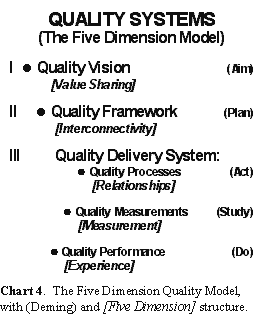 The traditional
three-dimension quality model, then, is actually the third stage--the delivery system--of
a three-part, five-dimension quality model. The first part (related to quality's fifth
dimension, value sharing) is Quality Vision. It involves comprehending the value of our
contribution to society now and in the future. The second part (related to
interconnectivity, the fourth dimension of quality) is Planning for Quality, or
establishing the Quality Framework. It involves developing a framework or environment in
which quality can thrive.
The traditional
three-dimension quality model, then, is actually the third stage--the delivery system--of
a three-part, five-dimension quality model. The first part (related to quality's fifth
dimension, value sharing) is Quality Vision. It involves comprehending the value of our
contribution to society now and in the future. The second part (related to
interconnectivity, the fourth dimension of quality) is Planning for Quality, or
establishing the Quality Framework. It involves developing a framework or environment in
which quality can thrive.
The quality system is not complete without all five dimensions. Without performance,
measurement, and processes there is no way to bring the Quality Vision into actualization.
But without planning and vision, the quality system will drift from fad to fad without any
clear direction. For this reason, vision and planning, though fourth and fifth dimension
functions, must become the primary focus of the quality system. Thus, they are the first
and second parts of the Model, with the first, second and third dimension functions
(performance, measurement, and processes) being the third part--the delivery system--of
the model.
The Fourth Dimension of Quality. Quality Planning is a fourth
dimension function related to Interconnectivity and Paradigm Logic. This phase is critical
because it sets the stage and builds the framework and the environment for quality
implementation.(17) Interconnectivity permits us to view
the interrelationships of dynamics. It is more than planning in the structured systems
sense. It goes beyond a Management by Objectives (MBO) structure to creating the entire
environment in which quality exists. It involves not only selecting the methods,
procedures, policies, and processes of the quality system, but also selecting and
nourishing the various paradigms under which quality can thrive.
An example of its application has been given by Peter Scholtes.(18)
A firm had a lengthy bereavement policy which specified very strict requirements for
employees to take three days bereavement leave. The management realized that the
strictness of the policy was undesirable for many employees, although it was designed to
prevent abuse. The firm assessed which employees were not likely to abuse the policy, and
determined that 95% of the employees could be trusted. The policy was in place for the 5%
who would likely abuse the policy. The firm decided to simplify the policy to permit
bereavement leave upon approval of the supervisor. While the incidence of bereavement
leave went up, the number of days actually taken decreased by 47%. By moving from a
non-trust paradigm to a trust paradigm, a quality result was achieved, resulting in
significant savings to the firm as well as greater fulfillment to employees.
But planning for quality, while a necessary condition for an effective quality system,
is not a sufficient condition. Dr. Deming points out that every system must have an aim.(19) In the Five Dimension Model this is the Vision. It is
vision, founded on value sharing (the fifth dimension of quality), which drives the
quality system.
The Fifth Dimension of Quality: Value Sharing and Vision. Vision has
often been described as a view of a future state of the organization. While vision
encompasses the future of the organization, it also encompasses the present, because it is
the present capacity of the organization which gives it the power to move to the future
state. In the five dimension model, vision is not a distant light on the horizon which
grows brighter and brighter as we draw nearer to it. Rather it is a burning fire within
which illuminates everything we do. Vision illuminates the future, but it also elucidates
the present. Vision is as relevant to the present as it is to the future. In fact, it is a
clear vision of the present which leads us into the future.
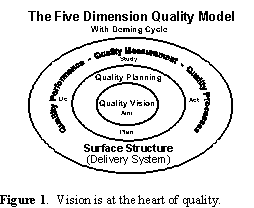 Vision is at the heart
of the Quality Model (see Figure 2). It supports the quality paradigms and delivery
systems. Vision is the comprehension of our value to society. In the Five Dimension Model,
Vision is described as the common good in a relationship. It deals with the existence of a
need on the part of one participant and the capacity on the part of the other
participant(s) to fulfill that need.(20) Under this
dynamic view of vision, it is always adjusting to meet the needs of participants. If the
needs change, the capacity is developed to meet the modified needs. The focus moves toward
sustaining relationships rather than simply satisfying needs.
Vision is at the heart
of the Quality Model (see Figure 2). It supports the quality paradigms and delivery
systems. Vision is the comprehension of our value to society. In the Five Dimension Model,
Vision is described as the common good in a relationship. It deals with the existence of a
need on the part of one participant and the capacity on the part of the other
participant(s) to fulfill that need.(20) Under this
dynamic view of vision, it is always adjusting to meet the needs of participants. If the
needs change, the capacity is developed to meet the modified needs. The focus moves toward
sustaining relationships rather than simply satisfying needs.
Vision, then, is enhanced by knowledge of our capacity, including our competencies,
measurements, and systems.(21) Our capacity relates to our
ability to fulfill needs. A true knowledge of our capacity gives us a true knowledge of
the needs we can assist in fulfilling. This is the reason we are constantly amazed at what
is accomplished by a visionary. It is not that they walk on water or have angel wings.
Rather, it is that they understand their capacity, and they do not limit their capacity by
thinking in traditional paradigms. President John F. Kennedy, when he painted the vision
of being on the moon within a decade, was not simply describing a future hope. He was
describing a capacity which he knew existed. Since all the resources were not currently
available at that time, part of that capacity involved the ability to put together the
resources that were needed in order to fulfill the vision. If our view of our capacity is
limited, so is our vision. Consequently, limitations on our vision, and the resulting
limitations on our capacity, are often self-imposed.
The vision, or aim, of a quality system must have a very precise focus: to build and
sustain relationships. Let us suppose that the aim of a particular quality system is
something different from building and sustaining relationships: to increase profitability
by 30% in one year. This is perhaps a very commendable organizational aim, but it is not a
quality aim if it does not build and sustain relationships. In fact, it may have the
opposite effect of degrading or even destroying relationships with customers and employees
if wages are cut or prices are raised in order to increase profitability. This may result
in achievement of short-term goals, but if relationships are degraded, then the long-term
effect can be the exact opposite of the intended aim--erosion of the customer and employee
base and lagging profits.
With this five dimensional framework we can develop a definition of quality that
focuses on the precise aim of quality: Quality is the on-going process of building
and sustaining relationships by assessing, anticipating, and fulfilling stated and implied
needs. Under this definition, both the "hard side" and the "soft
side" of quality are important. If the "soft side" relationship is not
maintained, the "customer" will not "order" products or services and
there will no longer be the opportunity to fulfill needs. If the "hard side" is
not maintained by providing products or services which actually fulfill the needs, then
the relationship will be degraded, reducing or eliminating the opportunity to fulfill
needs.
It is the fifth dimension of quality--the value sharing dimension--which provides the
power to build and sustain relationships. Value sharing is linked with vision (which is
defined as "a description of the common good in a relationship"). Value sharing
is described as follows: "If I give you something that has more value to you than it
does to me, then together we are better off as a result of the trade. For example,
"If I give you something that is worth $10 to you but $3 to me, then after the trade
we, together, are worth $10 rather than $3--even if I do not receive anything in
exchange.
There are three conditions necessary for value sharing to take place: First, there must
be a trusting relationship such that value to you is value to me. This is the core, or
essence, of shared vision. It is derived from common values and the interactive dynamics
related to these values. Second, there must be mutual sharing of resources, including
human (time), information, and capital resources. It is through the mutual sharing of
resources that resources are available where they are needed, when they are needed, to
fulfill needs as they arise. Hoarding of resources removes them from the free interchange
needed for an efficient and equitable socioeconomic environment. Third, there must be
sharing of value, with no hoarding of value by either participant. The hoarding of value
chills the sharing of value.
When value sharing takes place, the resulting environment is one in which participants
1) give more than is required, 2) become "sustaining members" (such as long-term
employees and loyal customers), and 3) share the vision with others (through word-of-mouth
advertising, for example). Where this type of relationship exists, a "buyer"
will pay more and a "seller" will accept less, expanding the trading range and
increasing the likelihood that a trade will take place. The relationship becomes more
important than the trade, and the focus turns from "selling to the customer" to
"fulfilling customer needs." Price becomes less important, and is adjusted to
meet the needs of participants.
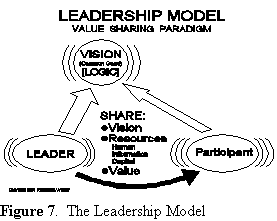 Leadership and
Management. In the value sharing dimension, leadership is the primary tool of
governance. The leadership process is simple yet powerful (see Figure 3).
The leader develops a vision for the organization and shares it with the other
participants. Then all participants engage in sharing vision, resources (human/time
resources, information/knowledge resources, and financial/capital resources), and value.
All of this is bound together by the vision and its logical implementation.
Leadership and
Management. In the value sharing dimension, leadership is the primary tool of
governance. The leadership process is simple yet powerful (see Figure 3).
The leader develops a vision for the organization and shares it with the other
participants. Then all participants engage in sharing vision, resources (human/time
resources, information/knowledge resources, and financial/capital resources), and value.
All of this is bound together by the vision and its logical implementation.
In the leadership model, leadership begins and ends with shared vision. Shared vision
becomes the lifeblood of leadership. When vision fades, so does leadership. Vision is
driven by the underlying paradigm of the participants, and as such, becomes the logic by
which the activities of the participants are understood.
In the value sharing paradigm, the vision of an organization is a description
of the common good that is derived from the relationship among its participants.
Consequently, the vision cannot be fully defined until an understanding is reached as to
who the participants are, since, in the quality process it is the fulfillment of the needs
of these participants which drives the quality improvement process.
Vision is directed toward the needs of each and all participants. Vision is the node
which binds the participants together. Consequently, in relational economics, if vision is
not shared, it does not exist. If the vision does not address the needs of a participant,
then the vision is not (and cannot be) shared by that participant.
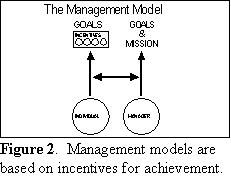 Anything less than
leadership does not have the power to fulfill all the dimensions of quality. For example,
management by objective, decried by Dr. Deming, uses only three dimensions (see Figure 4).
It operates on an incentive system in which ideally the goals of the organization are tied
to extrinsic rewards for the employees. As the employees do the work necessary to achieve
the incentive (in the achievement paradigm), the work of the corporation is accomplished.
However, if the goals of the corporation change to respond to new market needs, it is very
difficult to change the incentives. Yet unless they are changed, the employees continue to
work toward the wrong objectives.
Anything less than
leadership does not have the power to fulfill all the dimensions of quality. For example,
management by objective, decried by Dr. Deming, uses only three dimensions (see Figure 4).
It operates on an incentive system in which ideally the goals of the organization are tied
to extrinsic rewards for the employees. As the employees do the work necessary to achieve
the incentive (in the achievement paradigm), the work of the corporation is accomplished.
However, if the goals of the corporation change to respond to new market needs, it is very
difficult to change the incentives. Yet unless they are changed, the employees continue to
work toward the wrong objectives.
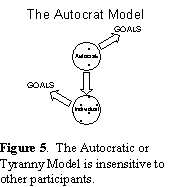 Worse yet is the tyranny
or autocratic model, which exists only in the experience dimension (see Figure 4). The
autocrat has no sensitivity to the needs of others and imposes his or her will on them.
This breeds the punishment paradigm ("get back" or "get even") or the
apathy paradigm ("I'll put in my 40 hours a week, but do not ask me to do anything
extra.").
Worse yet is the tyranny
or autocratic model, which exists only in the experience dimension (see Figure 4). The
autocrat has no sensitivity to the needs of others and imposes his or her will on them.
This breeds the punishment paradigm ("get back" or "get even") or the
apathy paradigm ("I'll put in my 40 hours a week, but do not ask me to do anything
extra.").
As leadership is implemented, it becomes synonymous with quality. The primary function
of quality is in meeting the needs of internal and external customers. Fulfilling quality
comes from identifying the participants and the vision, identifying which participants
will provide what resources, and identifying how the value will be shared among
participants.
MODERN MANAGEMENT THEORIES(22)
With this five-dimension framework, we can now link modern management theories to the
quality Model. But first let us re-draw the model in terms of its core components. These
are: core vision, core logic, core competencies, core measurements, and core systems.
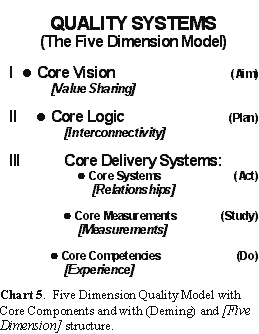 One of the modern
management theories, reengineering, has its foundation in Phase I of the Model, core
vision, which relates to the value sharing (fifth) dimension of quality. Phase I relates
to the underlying dynamics, which may or may not be in alignment with the surface
structure, but which must be in alignment in order to achieve quality's highest
fulfillment. Two others (organizational architecture and principle-centered leadership)
relate to the interconnectivity (fourth) dimension (Phase II of the Model). They relate to
the paradigms or frames of reference underlying and supporting the surface structure.
Finally, three of the modern management theories (organizational learning, core
competencies, and time-based competition) relate to the three-part delivery system (Phase
III of the Quality Model), which in turn relate to the first three dimensions of quality
(experience, measurement and systems). However, the modern management theories treat this
surface structure as an interactive whole rather than as separate pieces, as it is
sometimes treated in quality.
One of the modern
management theories, reengineering, has its foundation in Phase I of the Model, core
vision, which relates to the value sharing (fifth) dimension of quality. Phase I relates
to the underlying dynamics, which may or may not be in alignment with the surface
structure, but which must be in alignment in order to achieve quality's highest
fulfillment. Two others (organizational architecture and principle-centered leadership)
relate to the interconnectivity (fourth) dimension (Phase II of the Model). They relate to
the paradigms or frames of reference underlying and supporting the surface structure.
Finally, three of the modern management theories (organizational learning, core
competencies, and time-based competition) relate to the three-part delivery system (Phase
III of the Quality Model), which in turn relate to the first three dimensions of quality
(experience, measurement and systems). However, the modern management theories treat this
surface structure as an interactive whole rather than as separate pieces, as it is
sometimes treated in quality.
Phase I: Dynamics. Phase I of the Quality Model is the most important
phase of quality because it deals with the dynamics integrating the value systems of the
participants in an organization or undertaking. Yet it is the most complex, the least
apparent, and the most often ignored phase of the Model, because emphasis is placed on the
more visible three-dimension delivery system. Without value sharing, a quality system can
fall into the trap of delivering products or services without fulfilling needs, and thus
fail to accomplish the true underlying vision or aim of the system.
Reengineering is an excellent tool to bring the delivery system into alignment with the
underlying values and dynamics. Hammer and Champy describe reengineering as
"starting with a clean slate" to restructure a process or system to better
respond to customer needs instead of merely fitting the design of the organization.(23) For example, they describe an order and billing process
that was so fragmented (because various steps in the process were handled by different
departments) that customers were unable to verify the status of an order without
significant delay. Reengineering of business processes has resulted in quantum leap
improvements in cycle time or cost savings, rather than in just incremental improvements
traditionally associated with total quality management. It is this which led Hammer and
Champy to assert that reengineering is not TQM or any other form of the current quality
movement.
However, to understand and apply reengineering, it is essential to understand the
dynamics underlying a process. This is a fifth dimension quality function which relates to
building and sustaining relationships with customers. Dynamics are at the core of every
process, and the dynamics relate to the value systems of participants in the process.
Virtually every example given by Hammer and Champy deals with reengineering a process to
better respond to needs of internal and external customers, and thus to build and sustain
relationships among the key participants of a process.
Reengineering becomes necessary when the systems and processes of the surface structure
are out of alignment with the underlying dynamics. This can result from a faulty design of
the process in the first place, such as a design which matches the structure of the
organization rather than the needs of the customer. But it can also occur when, as often
happens, the underlying dynamics change. In today's market, this can occur on an annual,
quarterly, monthly, or even a weekly or daily basis.
Reengineering, then, involves first assessing the underlying dynamics, and then
structuring the systems and processes to respond to those dynamics. This requires
knowledge of the organization's core competencies, because the system design must either
reflect these competencies or allow for acquisition of the necessary competencies to
support the re-engineered system.(24)
Dr. Peter Senge, in his discussion of dynamic systems thinking, has described one of
the best methods for assessing and understanding the underlying dynamics of a system.
Using a series of loops to represent reinforcing cycles and balancing cycles, he provides
a "language" which can be used to map a dynamic interaction. Such a map can then
be used to design the appropriate process for the dynamic.(25)
Phase II: Paradigms. Phase II of the Quality Model deals with the
fourth dimension quality function of providing the framework or environment for quality.
Organizational architecture and principle-centered leadership are fourth dimension
functions. They both deal with the frame of reference of the participants in the
organization. By modifying the organizational structure to permit the paradigms of the
organization to become more closely aligned with the paradigms of the participants, the
organization captures the power of the aggregate internal desire of the participants. This
power is much greater and much more responsive to customer needs and organizational vision(26) than is the power of extrinsic rewards, which are rigid
and non-responsive to change, and which wane in value as the values of the participants
change.
Organizational architecture, developed by David Nadler, deals with the
restructuring of the organization to bring into congruence the work, the people, the
formal structure of the organization, and the informal structure and processes. This often
results in autonomous, self-directed work teams or business units in which employees and
teams are empowered to make decisions traditionally restricted to upper management. This
empowerment (referred to as "high performance involvement by Edward E. Lawler III) is
nourished where there is a high level of stewardship (responsible use of resources) and a
high level of consecration (dedication of resources to a common good).
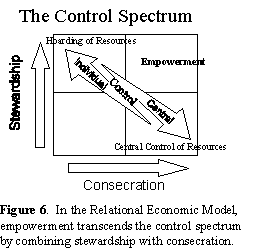 As the relational
economic model illustrates,(27) empowerment transcends the
control dynamics of traditional management theory where resources are hoarded through lack
of willingness to consecrate or share them for a community good; or where resources are
centrally controlled through enforced consecration or bureaucracy which eliminates
stewardship (see Figure 5). Empowerment creates the most efficient economic system because
resources are used responsibly (stewardship) and are put where they are needed when they
are needed (consecration) rather than being tied up in a particular department (hoarding)
or being subject to strict controls and extensive red tape (central planning or
bureaucracy). An example of hoarding of resources is the aircraft repair that was delayed
overnight at substantial cost to the airline because one organization was not willing to
bear the cost of a $100 hotel room for a maintenance crew member.(28)
As the relational
economic model illustrates,(27) empowerment transcends the
control dynamics of traditional management theory where resources are hoarded through lack
of willingness to consecrate or share them for a community good; or where resources are
centrally controlled through enforced consecration or bureaucracy which eliminates
stewardship (see Figure 5). Empowerment creates the most efficient economic system because
resources are used responsibly (stewardship) and are put where they are needed when they
are needed (consecration) rather than being tied up in a particular department (hoarding)
or being subject to strict controls and extensive red tape (central planning or
bureaucracy). An example of hoarding of resources is the aircraft repair that was delayed
overnight at substantial cost to the airline because one organization was not willing to
bear the cost of a $100 hotel room for a maintenance crew member.(28)
Principle-centered leadership. developed by Stephen R. Covey, deals with
modifying or structuring the organization's control system to respond to the values of the
members of the organization, and building the organization on a paradigm of partnership,
trust, and integrity. "Effective people lead their lives and manage their
relationships according to principles--natural laws and governing values that are
universally valid."(29) For some organizations this
can represent a major shift in paradigms. But the shift in paradigms can result in a
seemingly serendipitous shift in behavior. What, in fact, underlies this process is the
principle that the paradigm drives the behavior and provides the logic for it. What may
seemingly be illogical under one paradigm is completely logical under another. This
paradigm logic is illustrated in the bereavement policy example noted above. A traditional
lawyer would view the change of the bereavement policy from one with strict controls to
one that was totally at the discretion of the supervisor as totally illogical. The new
policy presented a significant possibility for abuse. But to the firm and its employees,
the shift was totally logical, and the resulting behavior verified the wisdom of the
logic. The detailed, strict bereavement policy had become a surrogate for trust, but had
actually destroyed trust and responsibility. By modifying the policy, the firm replaced
the surrogate with genuine trust, and was richly rewarded financially and with an increase
in employee morale.
Phase III: Surface Structure. Organizational learning, core
competencies, and time-based competition all relate to the surface structure, or delivery
system (Phase III), of the quality Model. This is the part of the quality system that is
most visible and thus the most easily understood.
Organizational learning, a concept developed by Dr. Peter Senge, deals with the
ability of the organization to learn from its experience.(30)
Many organizations have a learning disability simply because they have not learned how to
learn. Senge points out that in sports or in the performing arts we have perfected the art
of practice--of repeating our experience many times in order to perfect it prior to actual
performance. Yet we have not carried the practice concept to the business organization. So
we often end up failing on the front line merely from lack of practice. The Japanese
obsession with market share is directed toward increasing their "practice time"
and thus increasing their organizational learning in order to decrease costs and become
even more competitive.
The successful organization is one that can incorporate its experience into an
organizational pool of knowledge. The three dimension surface structure of the quality
model is what supports organizational learning. The organization's experience or
performance (the "Do" part of the Deming cycle) is measured
("Studied") to provide knowledge of the system. Then processes are developed,
modified, and standardized (the "Act" part of the Deming cycle) to capture the
learning as part of the system. This learning cycle takes place on a continuous basis.
Thus, the organizational pool of knowledge includes not only the experience of the
organization, but also the measurements and processes which codify that experience base.
This process of standardization helps the organization "become free of mortal
risk."(31)
It is this organizational learning which helps the organization develop its core
competencies, a concept developed by C. K. Prahalad. Core competencies are the
collective skills and knowledge which are unique to the organization and which relate to
the needs the organization intends to fulfill.(32) Core
competencies are the sum of the experience of the organization as reflected not only in
the performance or experience dimension of quality, but also in the second-dimension
measurements and third-dimension systems which support that performance. Core competencies
give the organization its reason for being, and are tied to the very existence of the
organization. Were it not for the ability of the organization to apply its human,
information, and capital resources to fulfilling a particular set of needs, it would not
survive.
High employee turnover and management mobility are antithetical to core competency
because it is impossible or impracticable to record all the nuances of a process that make
up the core competency, and when this experience base is reduced, some of the competency
is lost. One organization is now rehiring a number of engineers to whom it had given early
retirement because it has found that the experience base of those engineers cannot easily
be replicated.
Time-based competition, a concept developed by George Stalk, is an application
of learning theory to decrease the cycle time for performance of a process. The reduction
of cycle time increases the organization's capacity: if an organization can cut its cycle
time for a particular production process in half, it can produce twice as many parts in
the same amount of time.
One caution is critical. As important and exciting as organizational learning, core
competency, and time-based competition are, it is possible to lose sight of the fact that
they are part of the surface structure or delivery system of quality and still must be
integrated with the underlying paradigms and dynamics. For example, a firm can spend a lot
of time developing a core competency which is not in alignment with its customers' needs
or which is made obsolete by a shift in markets. Also, a firm may reduce cycle time for
product introduction, but find that its stock price is dropping because it is developing
less and less sophisticated products, albeit in a shorter time frame.(33)
If an organization does not use the complete quality Model, it may in fact end up using
some of these modern management tools to its detriment.
CONCLUSION
Equipped with a comprehensive five dimension quality framework, we can see beyond
quality's surface structure to its underlying paradigms and dynamics. This permits us to
see that many modern management theories, while sometimes bearing little resemblance to
quality processes at the surface level, are, in fact, quality processes. This allows us to
see quality as the sole source of modern management theory, and to use quality to evaluate
and embrace or reject these management theories as part of our quality process rather than
as separate, seemingly unrelated management fads. With this understanding, quality will
become central to the strategic planning process as organizations see quality integrated
with rather than adjunct to their existing operational systems.
ENDNOTES
1. Hammer, Michael and Champy, James, Reengineering the
Corporation, HarperBusiness, 1993, page 49.
2. Byrne, John A., "Management's New Gurus," Business
Week, August 21, 1992, pages 44-52.
3. "The Cost of Quality," Newsweek, September 7,
1992.
4. Albrecht, Karl, "The last days of TQM?" Quality
Digest, November 1992, page 16. Albrecht says, ". . . we are now in the last
stages of the 'total quality management (TQM)' phase of the quality movement. TQM, as
a formally adopted management model, will soon be as dead as management by objectives
(MBO) is. . . ."
5. Barker, Joel A., Future Edge, New York: William Morrow and
Company, Inc., 1992.
6. Lee, Thomas, Keynote Address, 1991 Midwest Quality Conference.
7. Lowenthal, Jeffrey N., "Blueprint for Service Quality"
Second Annual Service Quality Conference, April 20, 1993.
8. Deming, W. Edwards, The New Economics, Cambridge, Mass.:
Massachusetts Institute for Technology, Center for Advanced Engineering Study, 1993.
9. See Winder, Richard E., "Fulfilling Quality's Five
Dimensions," 47th Annual Quality Congress Transactions, May 24-26, 1993, pages
71-84.
10. See the Five Dimension Chart at the end of this article.
11. Deming, W. Edwards, Out of the Crisis, Cambridge, Mass.:
Massachusetts Institute for Technology, Center for Advanced Engineering Study, 1986, pages
36-48.
12. See Winder, Richard E., "Fulfilling Service Quality
Through Quality's Five Dimensions," 2nd Annual Service Quality Conference
Transcripts, April 20, 1993, for a detailed discussions of the Five Dimensions of quality.
13. Philip Crosby taught the importance of quality performance. See
Crosby, Philip B., Quality Without Tears, New York: McGraw-Hill, Inc., 1984.
14. This process is an important part of Dr. Deming's theory of
profound knowledge. Deming, W. Edwards, The New Economics, Cambridge, Mass.:
Massachusetts Institute for Technology, Center for Advanced Engineering Study, 1993, pages
104-110.
15. Dr. Deming taught how system and process measurements permit
the voice of the system to help us eliminate problems before they happen rather than
having to inspect them out.
16. "The good news is that in the post-Deming era we will be
freed from the statistical tyranny of the numbers nuts." Albrecht, Karl, "The
last days of TQM?" Quality Digest, November 1992, page 17.
17. Dr. Juran emphasizes the importance of planning for quality.
Quality Planning is the first step in his three-step model (the "Juran Trilogy")
that parallels the financial planning models used by business: planning, control, and
improvement. Juran, Joseph M., ed., and Frank M. Gryna, assoc. ed., Juran's Quality
Control Handbook, 4th Edition, (New York: McGraw-Hill), 1988, page 2.5.
18. Scholtes, Peter R., "Teamwork in the Quality Era,"
televised broadcast on April 14, 1992 in cooperation with the U. S. Chamber of Commerce,
George Washington University, and GW National Satellite Network.
19. Deming, The New Economics, pages 51-53.
20. Winder, Richard E., "Fulfilling Quality's Five
Dimensions," 47th Annual Quality Congress Transactions, May 24-26, 1993.
21. Jeffrey Lowenthal links core competencies to vision. See
Lowenthal, Jeffrey N., Reengineering the Organization (Milwaukee: Quality Press),
1993.
22. An excellent overview of these methods is contained in Byrne,
John A., "Management's New Gurus," Business Week, August 21, 1992, pages
44-52.
23. Hammer, Michael and Champy, James, Reengineering the
Corporation, HarperBusiness, 1993; see also Lowenthal, Jeffrey N., Reengineering
the Organization (Milwaukee: Quality Press), 1993.
24. Lowenthal's definition of organizational reengineering
integrates core competencies: Reengineering is "the rudimentary rethinking and
redesign of operating processes and organizational structure, focused on the
organization's core competencies, to achieve dramatic improvements in critical and
contemporary measures of performance such as reduced cost, increased product and service
quality, and increased market share and profitability. Lowenthal, Reengineering the
Organization, page 34.
25. Senge, Peter M., The Fifth Discipline, New York:
Doubleday/Currency, 1990.
26. Organizational vision is linked to the needs of the
organization's customers since vision is a description of the common good in the
relationship between an organization and its participants, including customers.
27. For a full discussion of the relational economic model, see
Winder, Richard E., Lindon J. Robison, and Daniel K. Judd, "The Economic Dynamics of
Quality," addendum to "Fulfilling Service Quality Through Quality's Five
Dimensions," 2nd Annual Service Quality Conference, April 20, 1992.
28. Hammer, Michael and Champy, James, page 8.
29. Covey, Stephen R., Principle-Centered Leadership (New
York: Summit Books), 1993.
30. Senge, Peter M., The Fifth Discipline, New York:
Doubleday/Currency, 1990.
31. Dr. Eugene Jennings of Michigan State University developed this
concept to help organizations standardize processes so they were not so dependent on a
particular individual that the disappearance of that individual would lead to business
failure.
32. See Prahalad, C. K., "The Core Competence of the
Corporation," Harvard Business Review, May-June, 1990; Lowenthal, Jeffrey N., Reengineering
the Organization, page 77.
33. Senge, Peter M., 47th Annual Quality Congress Keynote Address,
May 24-26, 1993.
REFERENCES
Albrecht, Karl, "The last days of TQM?" Quality Digest, November 1992,
page 16.
American Quality Foundation and Ernst and Young, Best Practice Report (New York:
American Quality Foundation and Ernst and Young), 1992.
Barker, Joel A., Future Edge, New York: William Morrow and Company, Inc., 1992.
Byrne, John A., "Management's New Gurus," Business Week, August 21,
1992, pages 44-52.
Churchill, Neil C. and Lewis, Virginia L., "The Five Stages of Small Business
Growth," Harvard Business Review, May-June, 1983, page 30.
Covey, Stephen R., Principle-Centered Leadership (New York: Summit Books), 1993.
Crosby, Philip B., Quality Without Tears, New York: McGraw-Hill, Inc., 1984.
Deming, W. Edwards, The New Economics, Cambridge, Mass.: Massachusetts Institute
for Technology, Center for Advanced Engineering Study, 1993.
Deming, W. Edwards, Out of the Crisis, Cambridge, Mass.: Massachusetts Institute
for Technology, Center for Advanced Engineering Study, 1986.
Hammer, Michael and Champy, James, Reengineering the Corporation,
HarperBusiness, 1993.
Juran, Joseph M., ed., and Frank M. Gryna, assoc. ed., Juran's Quality Control
Handbook, 4th Edition, (New York: McGraw-Hill), 1988.
Lowenthal, Jeffrey N., "Blueprint for Service Quality" Second Annual Service
Quality Conference, April 20, 1993.
Lowenthal, Jeffrey N., Reengineering the Organization (Milwaukee: Quality
Press), 1993.
Prahalad, C. K., "The Core Competence of the Corporation," Harvard
Business Review, May-June 1990.
Scholtes, Peter R., "Teamwork in the Quality Era," televised broadcast on
April 14, 1992 in cooperation with the U. S. Chamber of Commerce, George Washington
University, and GW National Satellite Network.
Senge, Peter M., The Fifth Discipline, New York: Doubleday/Currency, 1990.
Winder, Richard E., Lindon J. Robison, and Daniel K. Judd, "The Economic Dynamics
of Quality," addendum to "Fulfilling Service Quality Through Quality's Five
Dimensions," 2nd Annual Service Quality Conference April 20, 1992.
Winder, Richard E., "Fulfilling Quality's Five Dimensions," 47th Annual
Quality Congress Transactions, May 24-26, 1993.
 If modern
management theory is to be integrated with quality, we must first have a quality framework
that itself is complete. A recent shift in paradigms has opened the door to a five
dimensional quality framework that is comprehensive, integrative, and simple (see Chart 1
and The Five Dimensions of Quality chart at the end of this paper).(9)
This framework reflects underlying dynamics in a manner that it accounts for
competitiveness as well as competition, for partnership as well as punishment, for
leadership as well as management or bureaucracy.(10)
Utilizing this framework, the Five Dimension Quality Model provides an entirely new
definition of quality which is broad enough to encompass the fifty seven varieties of
quality as well as the emerging management theories.
If modern
management theory is to be integrated with quality, we must first have a quality framework
that itself is complete. A recent shift in paradigms has opened the door to a five
dimensional quality framework that is comprehensive, integrative, and simple (see Chart 1
and The Five Dimensions of Quality chart at the end of this paper).(9)
This framework reflects underlying dynamics in a manner that it accounts for
competitiveness as well as competition, for partnership as well as punishment, for
leadership as well as management or bureaucracy.(10)
Utilizing this framework, the Five Dimension Quality Model provides an entirely new
definition of quality which is broad enough to encompass the fifty seven varieties of
quality as well as the emerging management theories.  Integrating psychology,
leadership, and economics with quality dynamics, the Five Dimension Model utilizes
relational economic theory to lay a socioeconomic foundation for seeing quality as the
source of modern management theory rather than as a separate method or system (see Figure
1). The distinct advantage of this approach is that it provides a single source of
learning and permits an organization to focus its entire energy on building its strategic
plan around the quality paradigm rather than on an unfocused potpourri of methods. In a
symbionic manner, these modern management methods in turn make a significant contribution
to our understanding of quality. In fact, reengineering (Michael Hammer), organizational
architecture (David Nadler), principle-centered leadership (Stephen R. Covey),
organizational learning (Peter Senge), core competencies (C. K. Prahalad), and time-based
competition (George Stalk, Jr.), are multi-dimensional quality functions that lead us to
the highest (fifth) dimension of quality: delight the customer. These tools take us beyond
the shallow two-dimensional linear view of quality and even beyond the three dimensional
process view to a complete five-dimensional view of the quality system and its underlying
dynamics.
Integrating psychology,
leadership, and economics with quality dynamics, the Five Dimension Model utilizes
relational economic theory to lay a socioeconomic foundation for seeing quality as the
source of modern management theory rather than as a separate method or system (see Figure
1). The distinct advantage of this approach is that it provides a single source of
learning and permits an organization to focus its entire energy on building its strategic
plan around the quality paradigm rather than on an unfocused potpourri of methods. In a
symbionic manner, these modern management methods in turn make a significant contribution
to our understanding of quality. In fact, reengineering (Michael Hammer), organizational
architecture (David Nadler), principle-centered leadership (Stephen R. Covey),
organizational learning (Peter Senge), core competencies (C. K. Prahalad), and time-based
competition (George Stalk, Jr.), are multi-dimensional quality functions that lead us to
the highest (fifth) dimension of quality: delight the customer. These tools take us beyond
the shallow two-dimensional linear view of quality and even beyond the three dimensional
process view to a complete five-dimensional view of the quality system and its underlying
dynamics.  The Five Dimension
Quality Model, based on the five dimensions of quality, provides the means of integrating
cutting-edge management methods with quality processes. The reason the Five Dimension
Model is able to integrate modern management methods is that it deals with quality on the
surface level as well as on the paradigm and underlying dynamic level (see Chart 2). The
vast majority of quality training today takes place at the surface level. It is behavioral
oriented, and deals with what we can see and "control." On the other hand, both
quality and the most significant modern management methods have their roots at the dynamic
level, and must be understood and explained through dynamics rather than through surface
appearances and structures. On the surface, modern management techniques may appear quite
different from traditional quality processes. But at their core, they utilize the same
dynamic interactions. The Five Dimension Model assists us in linking quality with modern
management at the dynamic level, where the focus is on creating the environment in which
growth is natural because it results from nurturing the dynamics rather than controlling
the behavior. This gives us the ability to see modern management methods as part of,
rather than distinct from, quality systems and processes.
The Five Dimension
Quality Model, based on the five dimensions of quality, provides the means of integrating
cutting-edge management methods with quality processes. The reason the Five Dimension
Model is able to integrate modern management methods is that it deals with quality on the
surface level as well as on the paradigm and underlying dynamic level (see Chart 2). The
vast majority of quality training today takes place at the surface level. It is behavioral
oriented, and deals with what we can see and "control." On the other hand, both
quality and the most significant modern management methods have their roots at the dynamic
level, and must be understood and explained through dynamics rather than through surface
appearances and structures. On the surface, modern management techniques may appear quite
different from traditional quality processes. But at their core, they utilize the same
dynamic interactions. The Five Dimension Model assists us in linking quality with modern
management at the dynamic level, where the focus is on creating the environment in which
growth is natural because it results from nurturing the dynamics rather than controlling
the behavior. This gives us the ability to see modern management methods as part of,
rather than distinct from, quality systems and processes. The Five Dimension
Quality Model provides a basis for understanding that quality is a system and for
understanding what the quality system is. The traditional view of the quality system
identified three components: Quality Performance, Quality Measurement, and Quality Systems
and Processes (see Chart 3). These components comprise the first three dimensions of
quality: Experience, Measurement, and Relationships and Systems Thinking.
The Five Dimension
Quality Model provides a basis for understanding that quality is a system and for
understanding what the quality system is. The traditional view of the quality system
identified three components: Quality Performance, Quality Measurement, and Quality Systems
and Processes (see Chart 3). These components comprise the first three dimensions of
quality: Experience, Measurement, and Relationships and Systems Thinking. The traditional
three-dimension quality model, then, is actually the third stage--the delivery system--of
a three-part, five-dimension quality model. The first part (related to quality's fifth
dimension, value sharing) is Quality Vision. It involves comprehending the value of our
contribution to society now and in the future. The second part (related to
interconnectivity, the fourth dimension of quality) is Planning for Quality, or
establishing the Quality Framework. It involves developing a framework or environment in
which quality can thrive.
The traditional
three-dimension quality model, then, is actually the third stage--the delivery system--of
a three-part, five-dimension quality model. The first part (related to quality's fifth
dimension, value sharing) is Quality Vision. It involves comprehending the value of our
contribution to society now and in the future. The second part (related to
interconnectivity, the fourth dimension of quality) is Planning for Quality, or
establishing the Quality Framework. It involves developing a framework or environment in
which quality can thrive. Vision is at the heart
of the Quality Model (see Figure 2). It supports the quality paradigms and delivery
systems. Vision is the comprehension of our value to society. In the Five Dimension Model,
Vision is described as the common good in a relationship. It deals with the existence of a
need on the part of one participant and the capacity on the part of the other
participant(s) to fulfill that need.
Vision is at the heart
of the Quality Model (see Figure 2). It supports the quality paradigms and delivery
systems. Vision is the comprehension of our value to society. In the Five Dimension Model,
Vision is described as the common good in a relationship. It deals with the existence of a
need on the part of one participant and the capacity on the part of the other
participant(s) to fulfill that need. Leadership and
Management. In the value sharing dimension, leadership is the primary tool of
governance. The leadership process is simple yet powerful (see Figure 3).
The leader develops a vision for the organization and shares it with the other
participants. Then all participants engage in sharing vision, resources (human/time
resources, information/knowledge resources, and financial/capital resources), and value.
All of this is bound together by the vision and its logical implementation.
Leadership and
Management. In the value sharing dimension, leadership is the primary tool of
governance. The leadership process is simple yet powerful (see Figure 3).
The leader develops a vision for the organization and shares it with the other
participants. Then all participants engage in sharing vision, resources (human/time
resources, information/knowledge resources, and financial/capital resources), and value.
All of this is bound together by the vision and its logical implementation. Anything less than
leadership does not have the power to fulfill all the dimensions of quality. For example,
management by objective, decried by Dr. Deming, uses only three dimensions (see Figure 4).
It operates on an incentive system in which ideally the goals of the organization are tied
to extrinsic rewards for the employees. As the employees do the work necessary to achieve
the incentive (in the achievement paradigm), the work of the corporation is accomplished.
However, if the goals of the corporation change to respond to new market needs, it is very
difficult to change the incentives. Yet unless they are changed, the employees continue to
work toward the wrong objectives.
Anything less than
leadership does not have the power to fulfill all the dimensions of quality. For example,
management by objective, decried by Dr. Deming, uses only three dimensions (see Figure 4).
It operates on an incentive system in which ideally the goals of the organization are tied
to extrinsic rewards for the employees. As the employees do the work necessary to achieve
the incentive (in the achievement paradigm), the work of the corporation is accomplished.
However, if the goals of the corporation change to respond to new market needs, it is very
difficult to change the incentives. Yet unless they are changed, the employees continue to
work toward the wrong objectives.  Worse yet is the tyranny
or autocratic model, which exists only in the experience dimension (see Figure 4). The
autocrat has no sensitivity to the needs of others and imposes his or her will on them.
This breeds the punishment paradigm ("get back" or "get even") or the
apathy paradigm ("I'll put in my 40 hours a week, but do not ask me to do anything
extra.").
Worse yet is the tyranny
or autocratic model, which exists only in the experience dimension (see Figure 4). The
autocrat has no sensitivity to the needs of others and imposes his or her will on them.
This breeds the punishment paradigm ("get back" or "get even") or the
apathy paradigm ("I'll put in my 40 hours a week, but do not ask me to do anything
extra."). One of the modern
management theories, reengineering, has its foundation in Phase I of the Model, core
vision, which relates to the value sharing (fifth) dimension of quality. Phase I relates
to the underlying dynamics, which may or may not be in alignment with the surface
structure, but which must be in alignment in order to achieve quality's highest
fulfillment. Two others (organizational architecture and principle-centered leadership)
relate to the interconnectivity (fourth) dimension (Phase II of the Model). They relate to
the paradigms or frames of reference underlying and supporting the surface structure.
Finally, three of the modern management theories (organizational learning, core
competencies, and time-based competition) relate to the three-part delivery system (Phase
III of the Quality Model), which in turn relate to the first three dimensions of quality
(experience, measurement and systems). However, the modern management theories treat this
surface structure as an interactive whole rather than as separate pieces, as it is
sometimes treated in quality.
One of the modern
management theories, reengineering, has its foundation in Phase I of the Model, core
vision, which relates to the value sharing (fifth) dimension of quality. Phase I relates
to the underlying dynamics, which may or may not be in alignment with the surface
structure, but which must be in alignment in order to achieve quality's highest
fulfillment. Two others (organizational architecture and principle-centered leadership)
relate to the interconnectivity (fourth) dimension (Phase II of the Model). They relate to
the paradigms or frames of reference underlying and supporting the surface structure.
Finally, three of the modern management theories (organizational learning, core
competencies, and time-based competition) relate to the three-part delivery system (Phase
III of the Quality Model), which in turn relate to the first three dimensions of quality
(experience, measurement and systems). However, the modern management theories treat this
surface structure as an interactive whole rather than as separate pieces, as it is
sometimes treated in quality. As the relational
economic model illustrates,
As the relational
economic model illustrates,